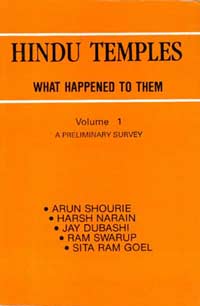Introduction > Page1

Chapter Ten
Let the Mute Witnesses Speak
- by Sita Ram Goel
The cradle of Hindu culture1 on the eve of its Islamic invasion included what are at present the Sinkiang province of China, the Transoxiana region of Russia, the Seistan province of Iran and the sovereign states of Afghanistan, Pakistan, India, Nepal and Bangladesh. The Islamic invasion commenced around 650 A.D., when a Muslim army secured a foothold in Seistan, and continued till the end of the eighteenth century, when the last Islamic crusader, Tipu Sultan, was overthrown by the British. Hordes of Arabs, Persians, Turks, and Afghans who had been successively inspired by the Theology of Islam poured in, in wave after wave, carrying fire and sword to every nook and corner of this vast area. In the process, Sinkiang, Transoxiana region, Seistan and Afghanistan became transformed into daru’l-IslĂm where all vestiges of the earlier culture were wiped out. The same spell has engulfed the areas which were parts of India till 1947 and have since become Pakistan and Bangladesh.
We learn from literary and epigraphic sources, accounts of foreign travellers in medieval times, and modern archaeological explorations that, on the eve of the Islamic invasion, the cradle of Hindu culture was honeycombed with temples and monasteries, in many shapes and sizes. The same sources inform us that many more temples and monasteries continued to come up in places where the Islamic invasion had yet to reach or from where it was forced to retire for some time by the rallying of Hindu resistance. Hindus were great temple builders because their pantheon was prolific in Gods and Goddesses and their society rich in schools and sects, each with its own way of worship. But by the time we come to the end of the invasion, we find that almost all these Hindu places of worship had either disappeared or were left in different stages of ruination. Most of the sacred sites had come to be occupied by a variety of Muslim monuments-masjids and îdgăhs (mosques), dargăhs and ziărats (shrines), mazărs and maqbaras (tombs), madrasas and maktabs (seminaries), takiyăs and qabristăns (graveyards). Quite a few of the new edifices had been built from the materials of those that had been deliberately demolished in order to satisfy the demands of Islamic Theology. The same materials had been used frequently in some secular structures as well-walls and gates of forts and cities, river and tank embankments, caravanserais and stepwells, palaces and pavilions.
1 The word “Hindu” in the present context stands for all schools of Sanatana Dharma-Buddhism, Jainism, Saivism, Shaktism, Vaishnavism and the rest.
Author - Shri Sita Ram Goel
|